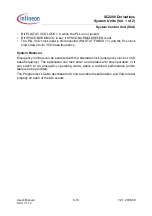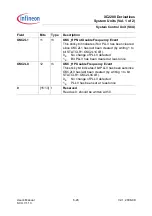
XC2200 Derivatives
System Units (Vol. 1 of 2)
System Control Unit (SCU)
User’s Manual
6-12
V2.1, 2008-08
SCU, V1.13
Note: Changing the system operation frequency by changing the value of the K1-Divider
has a direct influence on the power consumption of the device. Therefore, this has
to be done carefully.
The duty cycle of the clock signal depends on the selected value of the K1-Divider. This
can have an impact for the operation with an external communication interface.
The Prescaler Mode is requested from the Unlocked or Normal Mode by setting bit
PLLCON0.VCOBY. The Prescaler Mode is entered when the status bit
PLLSTAT.VCOBYST is cleared.
Before the Prescaler Mode is requested the K1-Divider should be configured with a value
generating a PLL output frequency
f
PLL
that matches the one generated by the Unlocked
or Normal Mode as much as possible. In this way the frequency change resulting out of
the mode change is reduced to a minimum.
The Prescaler Mode is requested to be left by clearing bit PLLCON0.VCOBY. The
Prescaler Mode is left when the status bit PLLSTAT.VCOBYST is set.
Configuration and Operation of the PLL Power Down Mode
The Power Down Mode is entered by setting bit PLLCON0.PLLPWD. While the PLL is
in Power Down Mode no PLL output frequency is generated.
Configuration and Operation of the PLL Sleep Mode
The Sleep Mode (also called VCO Power Down Mode) is entered by setting bit
PLLCON0.VCOPWD. While the PLL is in Sleep Mode only the Prescaler Mode is
operable. Selecting the Sleep Mode does not automatically switch to the Prescaler
Mode. Therefore, before the Sleep Mode is entered the Prescaler Mode must be active.
6.1.4.4
Trimmed Current Controlled Clock
The trimmed current controlled clock source can provide a clock
f
INT
for the PLL. This is
configured via bit PLLCON1.OSCSEL.
Note: The clock
f
INT
is also required for the operation of the oscillator watchdog.
6.1.4.5
Oscillator Watchdog
The oscillator watchdog continuously monitors the input clock
f
IN
. If the input frequency
becomes too low or if the input clock fails, this oscillator fail condition is indicated by
HPOSCCON.PLLV = 0 and an interrupt request is generated.
By setting bit HPOSCCON.OSCWDTRST the detection can be restarted without a reset
of the complete PLL, e.g. in case of a VCO loss-of-lock condition.






























